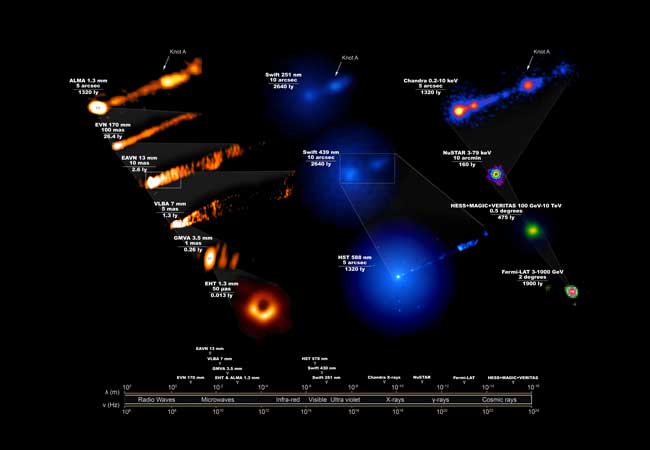
In April 2019, scientists – among them astrophysicists from Goethe University Frankfurt – released the first image of a black hole in the galaxy M87 using the Event Horizon Telescope (EHT). Now, 19 observatories collected light from across the spectrum that is emitted by the particle jet prduced by the supermassive black hole in the center of galaxy M87. This is the largest simultaneous observing campaign ever undertaken on a supermassive black hole with jets. The data promise to give unparalleled insight into this black hole and the system it powers, and to improve tests of Einstein’s General Theory of Relativity.
Professor Luciano Rezzolla, Theoretical Astrophysicists at Goethe University Frankfurt and EHT collaboration member, explains: “There is nothing that boosts our understanding of astronomical objects more than multi-wavelength observations, that is, the observation of the same object at different wavelengths. This is not very different from when we go to a doctor and we are ‘observed’ first in the optical (when we undress), then with X-rays, or with radio waves (when we are scanned): Our diagnosis becomes incredibly more accurate. The EHT collaboration and collaborating astronomers have carried out the most comprehensive observation of the centre of the galaxy M87, with observations that span 17 orders of magnitude in wavelength, from the radio to the gamma rays. These multi-wavelength observations have taught us a number of interesting things and a well-known lesson: Reality is far more complicated than our most sophisticated models, which we will have now to improve.”
The immense gravitational pull of a supermassive black hole can power jets of particles that travel at almost the speed of light across vast distances. M87’s jets produce light spanning the entire electromagnetic spectrum. This pattern is different for each black hole. Identifying this pattern gives crucial insight into a black hole’s properties (for example, its spin and energy output), but this is a challenge because the pattern changes with time.
The first results show that the intensity of the light produced by material around M87’s supermassive black hole was the lowest that had ever been seen. This produced ideal conditions for viewing the ‘shadow’ of the black hole, as well as being able to isolate the light from regions close to the event horizon from those tens of thousands of light-years away from the black hole. Scientists plan to use these data to improve their understanding about the material rotating around the black hole and being blasted away in jets, but also to reveal the origin of energetic particles called “cosmic rays”, which continually bombard the Earth from outer space. Their energies can be a million times higher than what can be produced in the most powerful accelerator on Earth, the Large Hadron Collider at CERN in Geneva, Switzerland. Because cosmic rays produce light via their collisions, the highest-energy gamma rays can pinpoint this location, and the new study indicates that these gamma-rays are likely not produced near the event horizon—at least not in 2017.
“We knew that the first direct image of a black hole would be groundbreaking,” said Kazuhiro Hada of the National Astronomical Observatory of Japan, a co-author of the new study on M87 to describe the large set of data. “But to get the most out of this remarkable image, we need to know everything we can about the black hole’s behavior at that time by observing over the entire electromagnetic spectrum.”
“There are multiple groups eager to see if their models are a match for these rich observations, and we’re excited to see the whole community use this public data set to help us better understand the deep links between black holes and their jets,” said co-author Daryl Haggard of McGill University in Montreal, Canada.
“This incredible set of observations includes many of the world’s best telescopes,” said co-author Juan Carlos Algaba of the University of Malaya in Kuala Lumpur, Malaysia. “This is a wonderful example of astronomers around the world working together in the pursuit of science.”
“Understanding the particle acceleration is really central to our understanding of both the EHT image as well as the jets, in all their ‘colors’,” said co-author Sera Markoff, from the University of Amsterdam. “These jets manage to transport energy released by the black hole out to scales larger than the host galaxy, like a huge power cord. Our results will help us calculate the amount of power carried, and the effect the black hole’s jets have on its environment.”
“With the release of these data, combined with the resumption of observing and an improved EHT, we know many exciting new results are on the horizon,” said co-author Mislav Baloković of Yale University.
Publication: Event Horizon Telescope Science Multi-Wavelength Science Working Group et al.: Broadband Multi-wavelength Properties of M87 During the 2017 Event Horizon Telescope Campaign. The Astrophysical Journal Letters, 911, L11, April 14, 2021, publication doi: 3847/2041-8213/abef71, data doi: 10.25739/mhh2-cw46. https://iopscience.iop.org/article/10.3847/2041-8213/abef71









